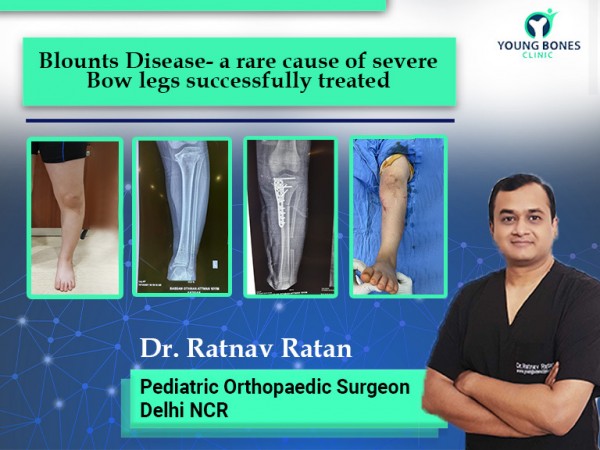
Dr. Ratnav Ratan, Delhi stresses on early surgical treatment to improve the lives of children with the Blounts’s Disease
It is imperative to treat children with suitable and timely treatment if detected with bone-related deformities. Immediate and timely treatment does improve their life while they attain total growth.
Delhi-based Dr. Ratnav Ratan, leading pediatric orthopedic surgeon refers to bowed legs, clubfoot, dislocated hip condition, in-toeing, scoliosis, missing limbs, muscular dystrophy, and other related conditions.
He shares a case of treating a 10 YO Iraqi boy with severe bowling of the left leg. The boy was suffering from juvenile Blount’s disease. His case history revealed an earlier failed surgery in Iraq. He walked with a lurch while the deformity was unsightly. He could not run properly or climb stairs while complaining of leg ache most of the time.
The Blounts disease also referred to as Tibia Vara, is a rare case of bow legs. It occurs either early or late during childhood or until adolescence. The best and the most reliable way to treat this condition is surgery.
The comprehensive surgical treatment includes growth modulation, osteotomy, bone lengthening, gradual deformity correction, and epiphysiodesis. The pediatric orthopedic surgeon undertakes careful preoperative planning and close follow-up to ensure the best possible outcomes in such cases. Unfortunately, there are high chances of recurrence for which repeat surgeries become essential.
Dr. Ratnav Ratan and his team meticulously planned to correct the deformity in one stage. Their preoperative planning included the exact bone cuts through long leg films and Scanogram.
The surgery included a hemiplateau elevation, fibulectomy, and a metaphyseal osteotomy. The new cuts were fixed with a plate while slight overcorrection was done to compensate for the possible relapse. The boy recovered quite well after the surgery. He can now walk and run with straight legs without any pain.
Speaking on the Blount's disease, Dr. Ratnav Ratan states that the most distinctive characteristic is the knees of such children bow outwards in relation to the pelvis. Generally, all children are born with bow legs. Still, if the child shows excessive bow-leggedness during the initial two years, then the parents should opt for an orthopedic evaluation right away. The child could be suffering from the Blount's Disease or rickets, which can be best diagnosed by a medical professional.
Apart from a confirmed diagnosis of the Blount's disease, the presence of associated conditions such as physiologic varus, achondroplasia, hypochondroplasia, and other dysplasia conditions need to be ruled outwhile recommending immediate treatment.
The Blount's disease develops because of early damage to the growth cartilage of the upper tibia and early weight-bearing. Observations have revealed that parents encourage their children to jump and walk before time using specially designed walking aids. As a result, the child puts additional load on the medial growth plate, thereby increasing the likelihood of developing Blount's disease sooner. Parents should be aware that the upper tibia has less bone and is relatively fragile during this growing phase. The tibia is the second largest bone in the body that bears the most weight.
An extension of infantile Blount's disease is Juvenile Blount's disease but is detected after the child turns four years old. But it is likely that Blount's disease has manifested to a greater extent causing more deformity as in this case
Elaborating the multiple procedures performed to treat this condition in general, an osteotomy involves cutting and realigning the bone, while in a tibial osteotomy, the tibia and the bone just below the knee is cut and realigned, reshaped for a natural look and functioning. Then, the bone is held in place with internal fixation or an external frame while the bone heals. If a hemiepiphysiodesis procedure is done then the orthopedic surgeon implants staples or plates are to restrict the bone’s growth on one side while the other side is allowed to keep growing to ensure normal growth on both sides of the leg. This procedure is a more gradual fix than an osteotomy.
Dr. Ratnav, a leading pediatric orthopedic surgeon in Delhi and Gurgaon emphasizes that early and suitable treatment of these conditions as and when they are diagnosed is very crucial. He urges the parents to be extra observant and opt for orthopedic evaluations regularly. He is available for consultation at W. Pratiksha Hospital and cell no. 082795 51675 for appointments
You should eat fruits every day, know why it's important
When should you think about donating your eggs? - Dr. Hrishikesh Pai